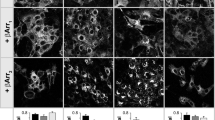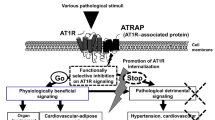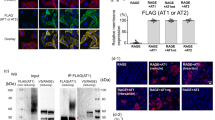Abstract
The vasopressor angiotensin II regulates vascular contractility and blood pressure through binding to type 1 angiotensin II receptors (AT1; refs 1, 2). Bradykinin, a vasodepressor, is a functional antagonist of angiotensin II (ref. 3). The two hormone systems are interconnected by the angiotensin-converting enzyme, which releases angiotensin II from its precursor and inactivates the vasodepressor bradykinin4. Here we show that the AT1 receptor and the bradykinin (B2) receptor also communicate directly with each other. They form stable heterodimers, causing increased activation of Gαq and Gαi proteins, the two major signalling proteins triggered by AT1. Furthermore, the endocytotic pathway of both receptors changed with heterodimerization. This is the first example of signal enhancement triggered by heterodimerization of two different vasoactive hormone receptors.
This is a preview of subscription content, access via your institution
Access options
Subscribe to this journal
Receive 51 print issues and online access
$199.00 per year
only $3.90 per issue
Buy this article
- Purchase on Springer Link
- Instant access to full article PDF
Prices may be subject to local taxes which are calculated during checkout




Similar content being viewed by others
References
Peach, M. J. Renin-angiotensin system: biochemistry and mechanisms of action. Physiol. Rev. 57, 313–370 (1977).
Dudley, D. T. et al. Subclasses of angiotensin II binding sites and their functional significance. Mol. Pharmacol. 38, 370– 377 (1990).
Parrat, J. R. Protection of the heart by ischemic preconditioning: mechanisms and possibilities for pharmacological exploitation. Trends Pharmacol. Sci. 5, 19–25 (1994).
Soubrier, F. et al. Two putative active centers in human angiotensin I-converting enzyme revealed by molecular cloning. Proc. Natl Acad. Sci. USA 85, 9386–9390 ( 1988).
AbdAlla, S., Jarnagin, K., Müller-Esterl, W. & Quitterer, U. The N-terminal amino group of [Tyr8]bradykinin is bound adjacent to analogous amino acids of the human and rat B2 receptor. J. Biol. Chem. 271, 27382–27387 (1996).
AbdAlla, S., Zaki, E., Lother, H. & Quitterer, U. Involvement of the amino terminus of the B2 receptor in agonist-induced receptor dimerization. J. Biol. Chem. 274, 26079– 26084 (1999).
Hein, L. et al. Overexpression of angiotensin AT1 receptor transgene in the mouse myocardium produces a lethal phenotype associated with myocyte hyperplasia and heart block. Proc. Natl Acad. Sci. USA 94, 6391–6396 (1997).
Borkowski, J. A. et al. Targeted disruption of a B2 bradykinin receptor gene in mice eliminates bradykinin action in smooth muscle and neurons. J. Biol. Chem. 270, 13706–13710 (1995).
Zhang, J., Ferguson, S. S. G., Barak, L. S., Menard, L. & Caron, M. G. Dynamin and β-arrestin reveal distinct mechanisms for G protein-coupled receptor internalization. J. Biol. Chem. 271, 118302–18305 (1996).
Ransnäs, L. A., Svoboda, P., Jasper, J. R. & Insel, P. A. Stimulation of β-adrenergic receptors of S49 lymphoma cells redistributes the α subunit of the stimulatory G protein between cytosol and membranes. Proc. Natl Acad. Sci. USA 86, 7900– 7903 (1989).
MacEwan, D. J., Kim, G. D. & Milligan, G. Analysis of the role of receptor number in defining the intrinsic activity and potency of partial agonists in neuroblastoma x glioma hybrid NG108-15 cells transfected to express differing levels of the human β2-adrenoceptor. Mol. Pharmacol. 48, 316–325 (1995).
Masaki, H. et al. Cardiac-specific overexpression of angiotensin II AT 2 receptor causes attenuated response to AT1 receptor-mediated pressor and chronotropic effects. J. Clin. Invest. 101, 527–537 (1998).
Nardone, J. & Hogan, P. G. Delineation of a region in the B2 bradykinin receptor that is essential for high-affinity agonist binding. Proc. Natl Acad. Sci. USA 91, 4417 –4421 (1994).
Prado, G. N., Taylor, L. & Polgar, P. Effects of intracellular tyrosine residue mutation and carboxyl terminus truncation on signal transduction and internalization of the rat bradykinin B2 receptor. J. Biol. Chem. 272, 14638–14642 (1997).
Hebert, T. E. et al. A peptide derived from a β2-adrenergic receptor transmembrane domain inhibits both receptor dimerization and activation. J. Biol. Chem. 271, 16384–16392 (1996).
Jordan, B. A. & Devi, L. A. G-protein-coupled receptor heterodimerization modulates receptor function. Nature 399, 697–700 (1999).
Romano, C., Yang, W. -L. & O'Malley, K. L. Metabotropic glutamate receptor 5 is a disulfide-linked dimer. J. Biol. Chem. 271, 28612– 28616 (1996).
Jones, K. A. et al. GABAB receptors function as a heteromeric assembly of the subunits GABABR1 and GABABR2. Nature 396, 674–679 ( 1998).
White, J. H. et al. Heterodimerization is required for the formation of a functional GABAB receptor. Nature 396, 679 –682 (1998).
Kaupmann, K. et al. GABAB-receptor subtypes assemble into functional heteromeric complexes. Nature 396, 683– 687 (1998).
Liu, F. et al. Direct protein–protein coupling enables cross-talk between dopamine D5 and γ-aminobutyric acid A receptors. Nature 493, 274–280 ( 2000).
Dixon, B. S., Sharma, R. V., Dickerson, T. & Fortune, J. Bradykinin and angiotensin II: activation of protein kinase C in arterial smooth muscle. Am. J. Physiol. 266, 406– 420 (1994).
Tsuchida, S. et al. Potent antihypertrophic effect of the bradykinin B2 receptor system on the renal vasculature. Kidney Int. 56, 509–516 (1999).
Bascands, J. L. et al. Bradykinin-induced in vitro contraction of rat mesangial cells via a B2 receptor type. Am. J. Physiol. 267, F871–F878 (1994).
Zhuo, J. et al. Localization and interactions of vasoactive peptide receptors in renomedullary interstitial cells of the kidney. Kidney Int. 67, S22–S28. ( 1998).
Quitterer, U. & Lohse, M. J. Crosstalk between Gα i- and Gαq-coupled receptors is mediated by Gβγ exchange. Proc. Natl Acad. Sci. USA 96, 10626–10631 (1999).
Quitterer, U., Zaki, E. & AbdAlla, S. Investigation of the extracellular accessibility of the connecting loop between membrane domains I and II of the bradykinin B 2 receptor. J. Biol. Chem. 274, 14773 –14778 (1999).
Mastro, R. & Hall, M. Protein delipidation and precipitation by tri-n-butylphosphate, acetone, and methanol treatment for isoelectric focusing and two-dimensional gel electrophoresis. Anal. Biochem. 273, 313–315 (1999).
Acknowledgements
We thank B. Nürnberg, for anti-Gα-common antibodies, and J. Heukeshoven for helpful advice on high-resolution electrophoresis of hydrophobic proteins. This work was supported in part by the Deutsche Forschungsgemeinschaft.
Author information
Authors and Affiliations
Corresponding author
Supplementary information
Rights and permissions
About this article
Cite this article
AbdAlla, S., Lother, H. & Quitterer, U. AT1-receptor heterodimers show enhanced G-protein activation and altered receptor sequestration. Nature 407, 94–98 (2000). https://doi.org/10.1038/35024095
Received:
Accepted:
Issue Date:
DOI: https://doi.org/10.1038/35024095
This article is cited by
-
Advances in the allostery of angiotensin II type 1 receptor
Cell & Bioscience (2023)
-
Risk factors for long-term survival in patients with ypN+ M0 rectal cancer after radical anterior resection
BMC Gastroenterology (2022)
-
Crosstalk between the renin–angiotensin, complement and kallikrein–kinin systems in inflammation
Nature Reviews Immunology (2022)
-
Angiotensin AT1 and AT2 receptor heteromer expression in the hemilesioned rat model of Parkinson’s disease that increases with levodopa-induced dyskinesia
Journal of Neuroinflammation (2020)
-
The renin-angiotensin-aldosterone system: a crossroad from arterial hypertension to heart failure
Heart Failure Reviews (2020)
Comments
By submitting a comment you agree to abide by our Terms and Community Guidelines. If you find something abusive or that does not comply with our terms or guidelines please flag it as inappropriate.



